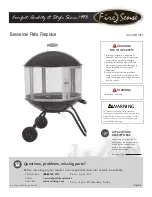
96
GB
Recommendations for prevention of Legionella growth (based on European standard
CEN/TR 16355)
INFORMATIVE
Legionella are small rod shaped bacteria which are a natural constituent of all fresh waters.
Legionaries’ disease is a serious pneumonia infection caused by inhaling the bacteria Legionella pneu-
mophilia or other Legionella species. This bacterium is frequently found in domestic, hotel and other
water systems and in water used for air conditioning or air cooling system. Hence the main intervention
against the condition is prevention, through control of the organism in water systems.
The European standard CEN/TR 16355 gives recommendations for good practice concerning the pre-
vention of Legionella growth in drinking water installations but existing national regulations remain in
force.
GENERAL RECOMMENDATIONS
“Conditions favourable to the proliferation of Legionella”. The following conditions are favourable to the
proliferation of Legionella:
• Water temperature in the range 25 - 50 °C. To reduce the proliferation of Legionella, the water tempe-
rature be kept with these limits to prevent them growing or reduce their growth to a minimum. If this
is not possible, the drinking water system must be sanitised thermally;
• Stagnant water. To prevent water stagnating for a long time, the drinking water system must be
fl
ushed
or made to run abundantly at least once a week;
• Nutrients, bio
fi
lms and sediment in the circuit, including boilers, etc. Sediment may promote the pro-
liferation of Legionella and should be regularly eliminated from water storage devices, boilers and
expansion/holding tanks (for instance, once a year).
Regarding to this storage water heater, if
1) the product is switched-o
ff
for a period of time [months] or
2) the water temperature is constantly maintained between 25°C and 50°C,
the Legionella bacteria could growth inside the tank. In these cases, to restrict the Legionella growth, it
is necessary to perform the so called “thermal disinfection cycle”. This electro-mechanical storage water
heater is sold with a thermostat set at a temperature higher than 60°C; it means it is enabled to carry
out a “thermal disinfection cycle” to restrict the Legionella growth inside the tank. This cycle complies
with the hot water installations and relevant recommendations for Legionella prevention speci
fi
ed in the
following Table 2 of the CEN/TR 16355.
Table 2 - Types of hot water system
Separate hot and cold water
Mixed hot and cold water
No
storage
Storage
No storage upline of the
mixer valves
Storage upline
of the mixer valves
No storage
upline of the mixer valves
No circulation
of hot water
Circulation
of hot water
No circulation
of hot water
Circulation
of hot water
No circulation
of hot water
Circulation
of hot water
No circulation
of hot water
Circulation
of hot water
No circulation
of hot water
Circulation
of hot water
Ref. in
Enclosure C
C.1
C.2
C.3
C4
C.5
C.6
C.7
C.8
C.9
C.10
Temperature
- -
≥
50 °C
e
in storage
heatera
a
≥
50 °C
e
thermal
disinfection
d
thermal
disinfection
d
in storage
heatera
a
≥
50 °C
e
thermal
disinfection
d
thermal
disinfection
d
thermal
disinfection
d
Stagnation
- -
≥
31
b
- -
≥
31
b
- -
≥
31
b
- -
≥
31
b
- -
≥
31
b
Sediment
- -
- -
remove
c
remove
c
- -
- -
remove
c
remove
c
- -
- -
a Temperature
≥
55°C all day or at least 1h a day
≥
60°C.
b Volume of water contained in the pipes between the circulation system and the most distant tap.
c Remove the sediment from the storage heater as required by local conditions, but no less frequently than once a year.
d Thermal disinfection for 20 minutes at 60°C, for 10 minutes at 65°C or 5 minutes at 70 °C at all delivery points at least once
a week.
e The water temperature in the circulation circuit may not fall below 50°C.
-- Not required





































